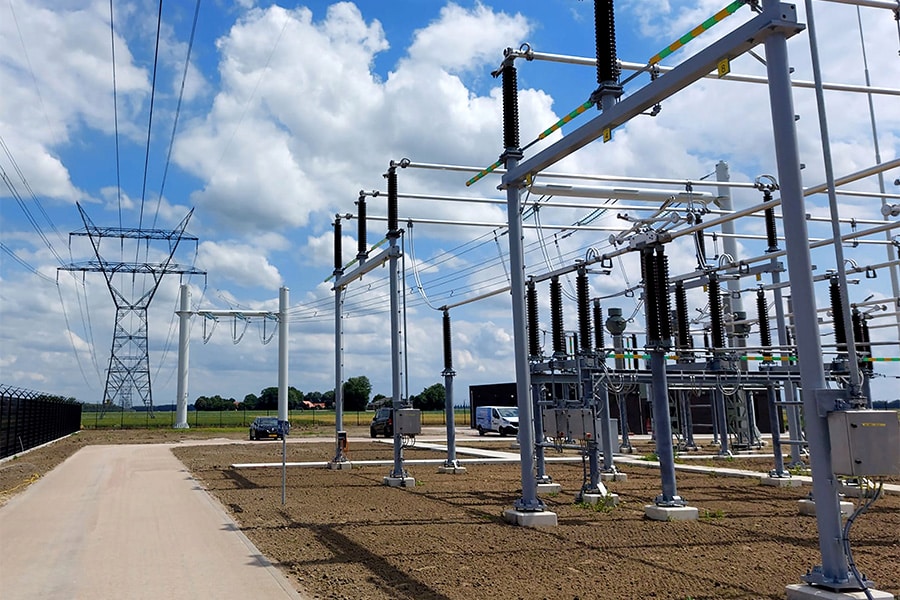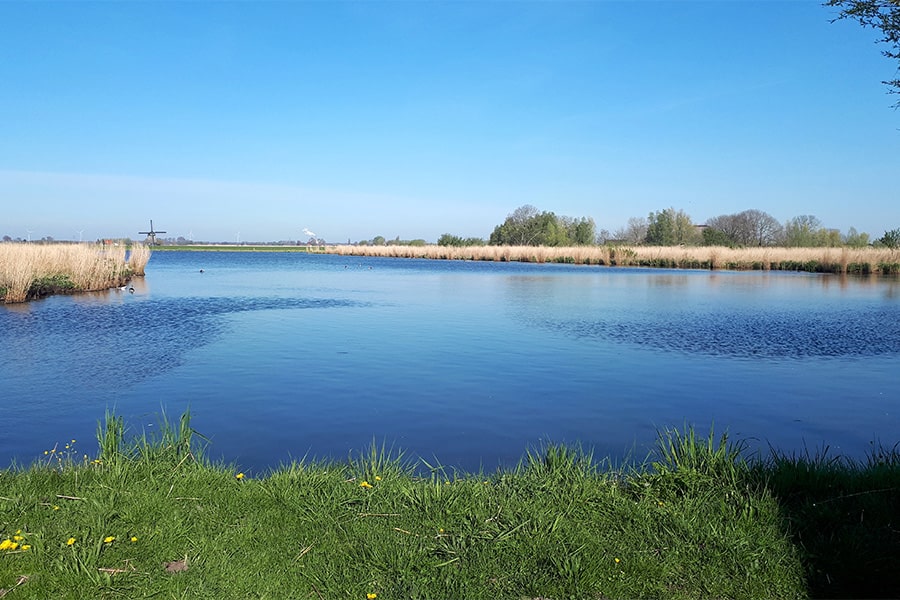
Self-closing Watershed Steyl-Maashoek
The power of simplicity
A world first is being built in picturesque Steyl on the Meuse River. To protect the Limburg monastery village and hinterland from high water in the future, Dijkzone Alliantie is realizing a unique self-closing floating barrier commissioned by Waterschap Limburg.®. A barrier that is unique in the world on this scale, but according to its makers will soon excel in simplicity. As a 'by-catch', the monastery village will also gain a beautiful recreational area: a balcony on the Meuse.
The Limburg Water Board is currently working on dozens of dike reinforcement projects within the national High Water Protection Program. One of these is the section near the Maashoek in Steyl, which was rejected a number of years ago under the new safety standards for height and piping, among other things. "In the past, the choice was made here for a flood barrier with a form of sight preservation at the level of the village square, because Steyl is designated as a protected village sight. At high water, a demountable barrier was placed here with all hands. A huge logistical operation and also error-prone," knows John Roubos, Technical Manager for Dike Reinforcement at Waterschap Limburg. "In addition, the existing retaining wall was so bad that at high water, the area inside the dike, including the village square, had to be flooded to create counter pressure for the Meuse. A situation that was no longer tenable."

Failure probability analysis
A dike reinforcement project is always customized, John continues. "The choice obviously depends on the flood safety requirements, but it must also fit in with the surroundings and, above all, the whole thing must be super reliable. Because this is a protected village site, a green dike was not an option, so a design had to be made in which the dike at rest does not obstruct the picturesque village site. Therefore, the concept arose based on a self-closing barrier. Variants of this type already exist in smaller form, but to make the system applicable to Steyl-Maashoek required a huge jump in scale." Richard Mooiman, Dike Reinforcement Contract Manager at Waterschap Limburg, adds: "So as a client, we had to come up with something that we very clearly needed the market to do. That's why a market consultation took place, a tender based on a competitive dialogue. Three parties then worked out a design for a self-closing barrier in which they had to demonstrate through a failure probability analysis that the design met the very strict reliability and watertightness requirements. From the Limburg Water Board, we were very surprised by the submission from Dijkzone Alliantie with a horizontal and hinged floating float barrier® in which technology and aesthetics reinforce each other in surprising ways while also creating an additional public living space."

Award-winning concept
Ploegam and Dura Vermeer have been forming the Dike Zone Alliance for ten years and have successfully executed several dike reinforcement projects in the past, such as Ruimte voor de Waal, area development Ooijen-Wanssum and dike reinforcement project Tiel-Waardenburg. "For each project we surround ourselves with regular partners and specifically for Steyl-Maashoek we have added Hollandia Infra, a leading party in the field of water retaining objects," says Ivo van Peer, Project Manager at contractor combination Dijkzone Alliantie Steyl - Maashoek. "We greatly appreciate that Waterschap Limburg gave us the opportunity and space to further develop our variant, which was not so well known." Richard replies, "If you choose to innovate, you shouldn't seal everything up. Otherwise it won't work." The concept of the self-closing flood barrier, by the way, is a further elaboration of the award-winning concept Float Barrier®. It is an idea of Gerard Jansen and Jan Vermond (Vlotterkering B.V.) in response to a European competition held by the Hoogheemraadschap van Delfland (Delfland Water Board) in 2007 to get people and companies to think about an alternative solution for a vertical barrier or embankment that meets all area and safety requirements. The barrier consists of linked horizontally hinged valves fitted with an EPS body situated above a concrete container. At high water, the basin fills with water and the valve hinges to its retaining height completely autonomously.
The creators of the system are proud that the Floating Barrier® is now becoming a reality. "After seventeen years of trial and error and unflinching determination, we are delighted to announce that the Floating Barrier® there is going to be. Looking back, it is an exceptional achievement to turn an idea into a product to be realized, which also involved us."

Flood safety innovation
In 2010, Dijkzone Alliantie partnered with the company Vlotterkering B.V. and a test rig was built in Hoek van Holland measuring 80 centimeters high and 40 meters long. "The setup was subjected to an extensive test program and passed all tests with flying colors. Reason for the Vlotterkering® as such in our product portfolio as a possible alternative to conventional dike reinforcement. With that concept we also participated in the tender for Spakenburg, but unfortunately did not win," Ivo acknowledges. "Then the concept was built on a smaller scale in TU Delft's experimental garden as a high-water safety innovation." It didn't stop there, as the concept was continually fine-tuned to take the next step. "The moment dike reinforcement Steyl-Maashoek came on the market, we decided as Dike Zone Alliance to scale up further and involve Hollandia Infra's knowledge and expertise. After all, we knew from the testing ground that the Vlotterkering® not exactly leakproof was. As such, the concept did not (yet) meet the high leak-tightness requirements set by Waterschap Limburg. A challenge, therefore."

Inverted floodgate
The stretch of dyke reinforcement Steyl-Maashoek is approximately 230 meters long, 138 meters of which will be constructed as a self-closing barrier with two self-closing coupures on either side. The water retaining height is approximately 3 meters. In order to demonstrate the functional requirements, the site of Hollandia Infra in Krimpen aan den IJssel already built a mock-up of the barrier during the tender phase at full size longitudinal, the retaining height. Anton van Kooij, senior structural engineer at Hollandia Infra says, "The concept of the float is in fact an inverted sluice gate, which, according to the specifications of Waterschap Limburg, has to close hermetically. Reason for Hollandia to engage Trelleborg Infrastructure, a specialist in rubber seals, and a regular partner of ours for many decades. The bundled knowledge was used to further optimize the design and test it again and again in the mock-up. It really was a process of trial and error, with the mock-up also constantly being modified to meet the high leak-tightness requirements." John admits that the water board set the stakes high. "That's only right in such an innovation project where we are working together to create a super reliable barrier," he believes. "We therefore look back with some admiration at how Dijkzone Alliance doggedly tackled this project, each time saying: it can be even better."

Balcony on the Meuse
The required reliability for closing the valve barrier is gigantic. In theory, the dam should only fail by not closing once every 100,000 years. "Demonstrating this is a challenge," John also knows. "However, the chosen solution excels in technical simplicity with components that actually cannot fail. Even in the highly unlikely event that the bearings of a valve part would fail, this part will be moved upward by the water pressure on the adjacent valve parts and the barrier will close completely. Moreover, the strength of this solution is that during normal conditions an additional public accommodation space is created, literally a balcony on the Meuse." Stephan Kweens, Technical Environmental Manager at contractor combination Dijkzone Alliantie: "Technology and spatial quality come together in this special project. The barrier functions as an outer dike deck, a beautiful place to walk over and enjoy the view of the Meuse River. At the same time, it provides more privacy for the people living near the water, because the "recreational area" is on the outside of the barrier. A win-win for all parties."

Millimeter work
Implementation has now started. Before the high water season, the Alliance has installed a sheet pile wall at an over height which functions as a seepage barrier as well as temporarily taking over the retaining function. After completion of the barrier, the over height will be burned off. "In this way, Steyl-Maashoek is also protected from high water during the work and we can demolish the existing barrier before the new barrier is built," says Stephan. "Then we install the foundation piles and the concrete container is made with cutouts for the hinge points of the steel valves. It really is millimeter work." Anton is confident and adds: "We made a special mold that matches the required dimensions and attachment points in the concrete container. Moreover, we can still accommodate a small tolerance in the construction. Thus, we are prepared to eliminate possible deviations in advance."

The goal is to have the barrier water safe before the new flood season on Oct. 15, 2024. Official completion, with the outside area fully landscaped, is scheduled for late 2024. "The barrier will close roughly once every four years, but of course the weather cannot be predicted," Richard rightly states. John concludes, "In addition, the barrier will be tested once a year according to the safety protocol of Waterschap Limburg and probably also activated at least once a year for demonstration purposes. The interest is great, including from abroad."



